engine overheat DODGE DART 2014 PF / 1.G User Guide
[x] Cancel search | Manufacturer: DODGE, Model Year: 2014, Model line: DART, Model: DODGE DART 2014 PF / 1.GPages: 656, PDF Size: 4.73 MB
Page 521 of 656
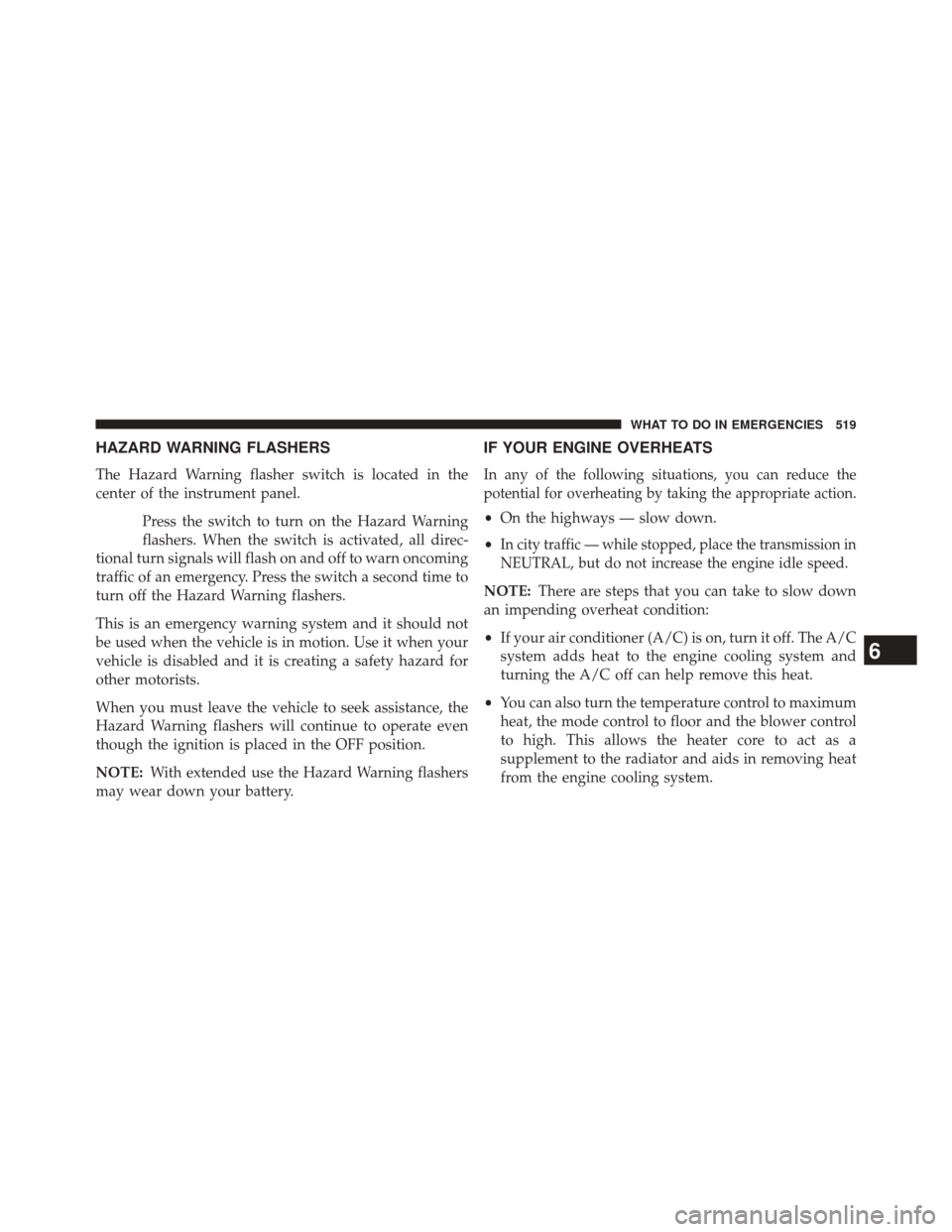
HAZARD WARNING FLASHERS
The Hazard Warning flasher switch is located in the
center of the instrument panel.Press the switch to turn on the Hazard Warning
flashers. When the switch is activated, all direc-
tional turn signals will flash on and off to warn oncoming
traffic of an emergency. Press the switch a second time to
turn off the Hazard Warning flashers.
This is an emergency warning system and it should not
be used when the vehicle is in motion. Use it when your
vehicle is disabled and it is creating a safety hazard for
other motorists.
When you must leave the vehicle to seek assistance, the
Hazard Warning flashers will continue to operate even
though the ignition is placed in the OFF position.
NOTE: With extended use the Hazard Warning flashers
may wear down your battery.
IF YOUR ENGINE OVERHEATS
In any of the following situations, you can reduce the
potential for overheating by taking the appropriate action.
• On the highways — slow down.
•
In city traffic — while stopped, place the transmission in
NEUTRAL, but do not increase the engine idle speed.
NOTE: There are steps that you can take to slow down
an impending overheat condition:
• If your air conditioner (A/C) is on, turn it off. The A/C
system adds heat to the engine cooling system and
turning the A/C off can help remove this heat.
• You can also turn the temperature control to maximum
heat, the mode control to floor and the blower control
to high. This allows the heater core to act as a
supplement to the radiator and aids in removing heat
from the engine cooling system.
6
WHAT TO DO IN EMERGENCIES 519
Page 550 of 656
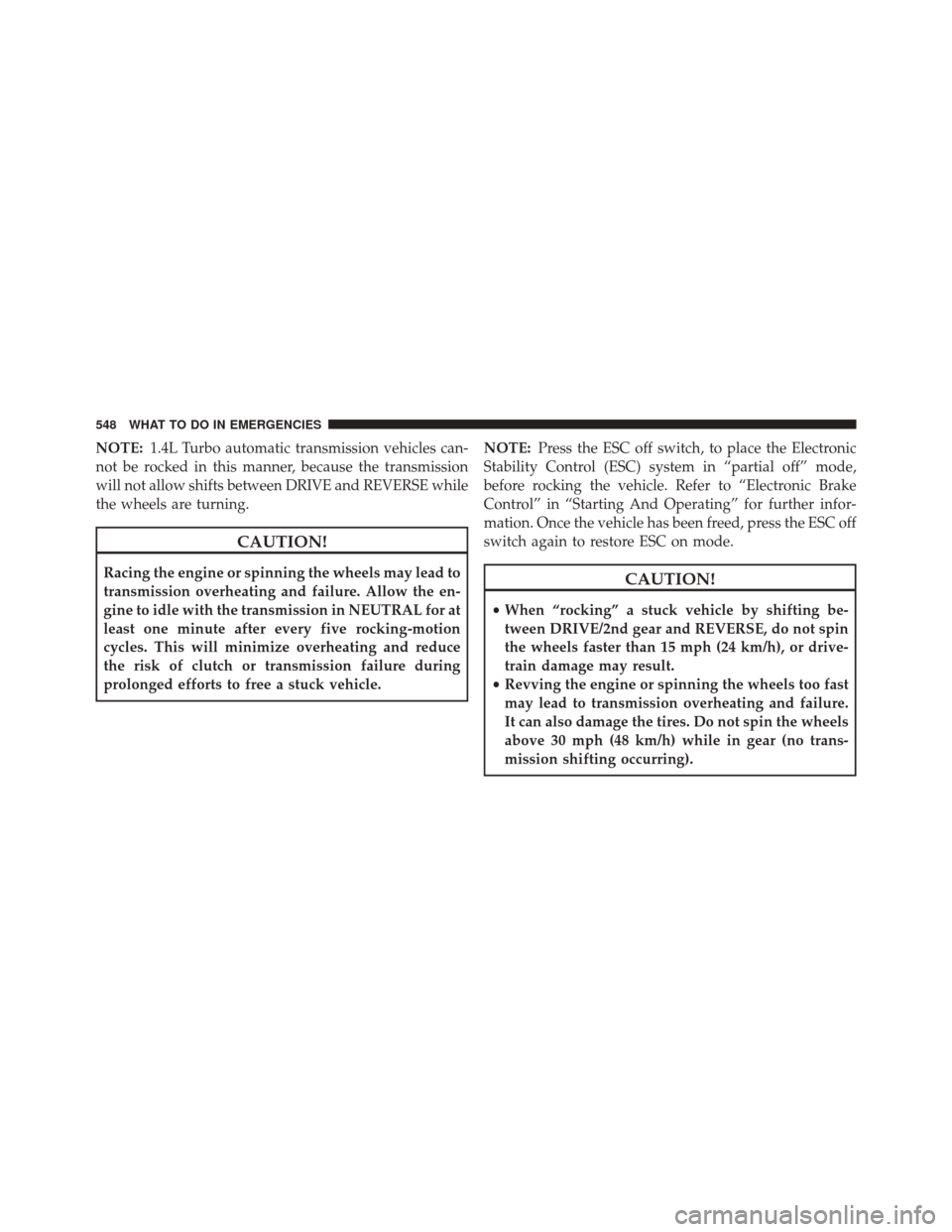
NOTE:1.4L Turbo automatic transmission vehicles can-
not be rocked in this manner, because the transmission
will not allow shifts between DRIVE and REVERSE while
the wheels are turning.
CAUTION!
Racing the engine or spinning the wheels may lead to
transmission overheating and failure. Allow the en-
gine to idle with the transmission in NEUTRAL for at
least one minute after every five rocking-motion
cycles. This will minimize overheating and reduce
the risk of clutch or transmission failure during
prolonged efforts to free a stuck vehicle. NOTE:
Press the ESC off switch, to place the Electronic
Stability Control (ESC) system in “partial off” mode,
before rocking the vehicle. Refer to “Electronic Brake
Control” in “Starting And Operating” for further infor-
mation. Once the vehicle has been freed, press the ESC off
switch again to restore ESC on mode.CAUTION!
• When “rocking” a stuck vehicle by shifting be-
tween DRIVE/2nd gear and REVERSE, do not spin
the wheels faster than 15 mph (24 km/h), or drive-
train damage may result.
• Revving the engine or spinning the wheels too fast
may lead to transmission overheating and failure.
It can also damage the tires. Do not spin the wheels
above 30 mph (48 km/h) while in gear (no trans-
mission shifting occurring).
548 WHAT TO DO IN EMERGENCIES
Page 578 of 656
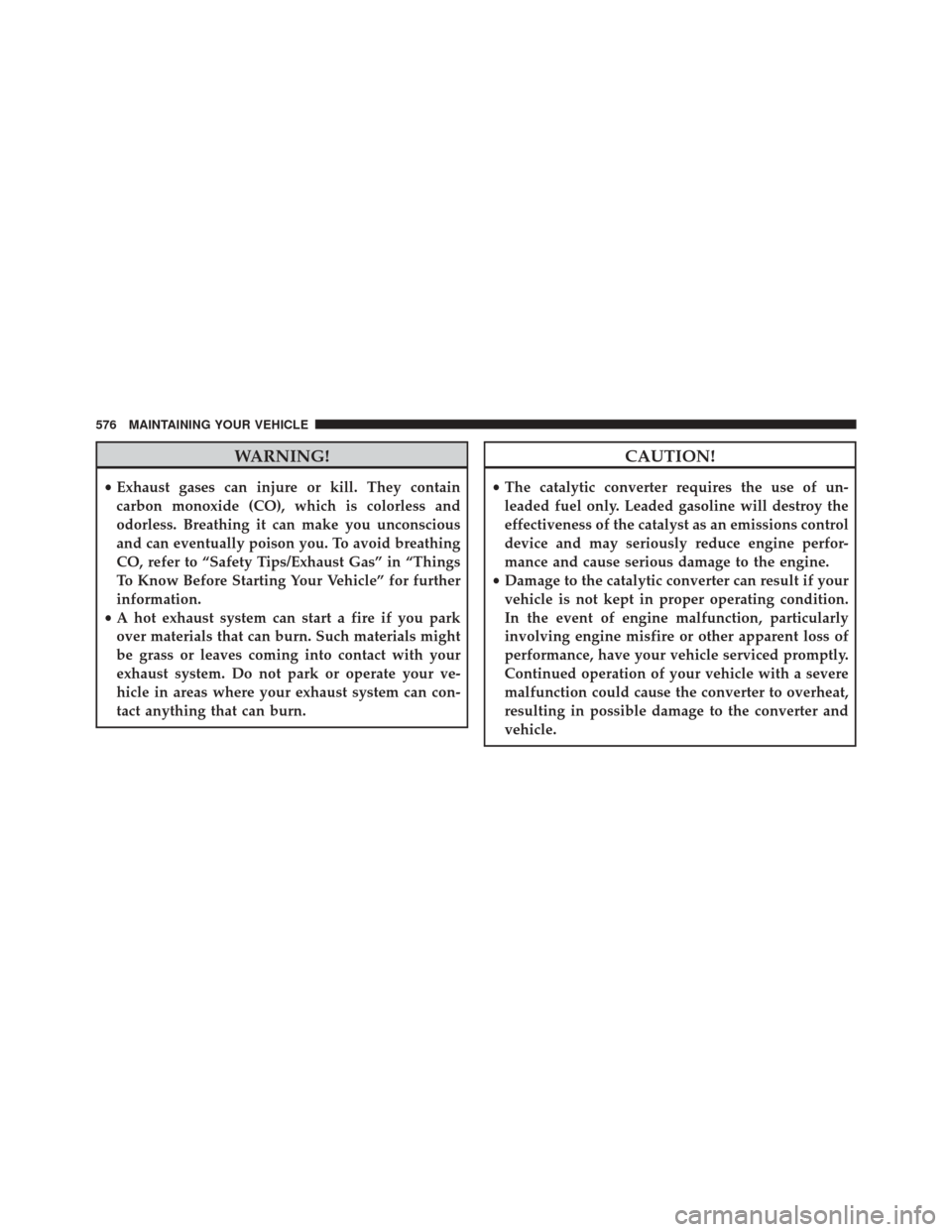
WARNING!
•Exhaust gases can injure or kill. They contain
carbon monoxide (CO), which is colorless and
odorless. Breathing it can make you unconscious
and can eventually poison you. To avoid breathing
CO, refer to “Safety Tips/Exhaust Gas” in “Things
To Know Before Starting Your Vehicle” for further
information.
• A hot exhaust system can start a fire if you park
over materials that can burn. Such materials might
be grass or leaves coming into contact with your
exhaust system. Do not park or operate your ve-
hicle in areas where your exhaust system can con-
tact anything that can burn.
CAUTION!
•The catalytic converter requires the use of un-
leaded fuel only. Leaded gasoline will destroy the
effectiveness of the catalyst as an emissions control
device and may seriously reduce engine perfor-
mance and cause serious damage to the engine.
• Damage to the catalytic converter can result if your
vehicle is not kept in proper operating condition.
In the event of engine malfunction, particularly
involving engine misfire or other apparent loss of
performance, have your vehicle serviced promptly.
Continued operation of your vehicle with a severe
malfunction could cause the converter to overheat,
resulting in possible damage to the converter and
vehicle.
576 MAINTAINING YOUR VEHICLE
Page 579 of 656
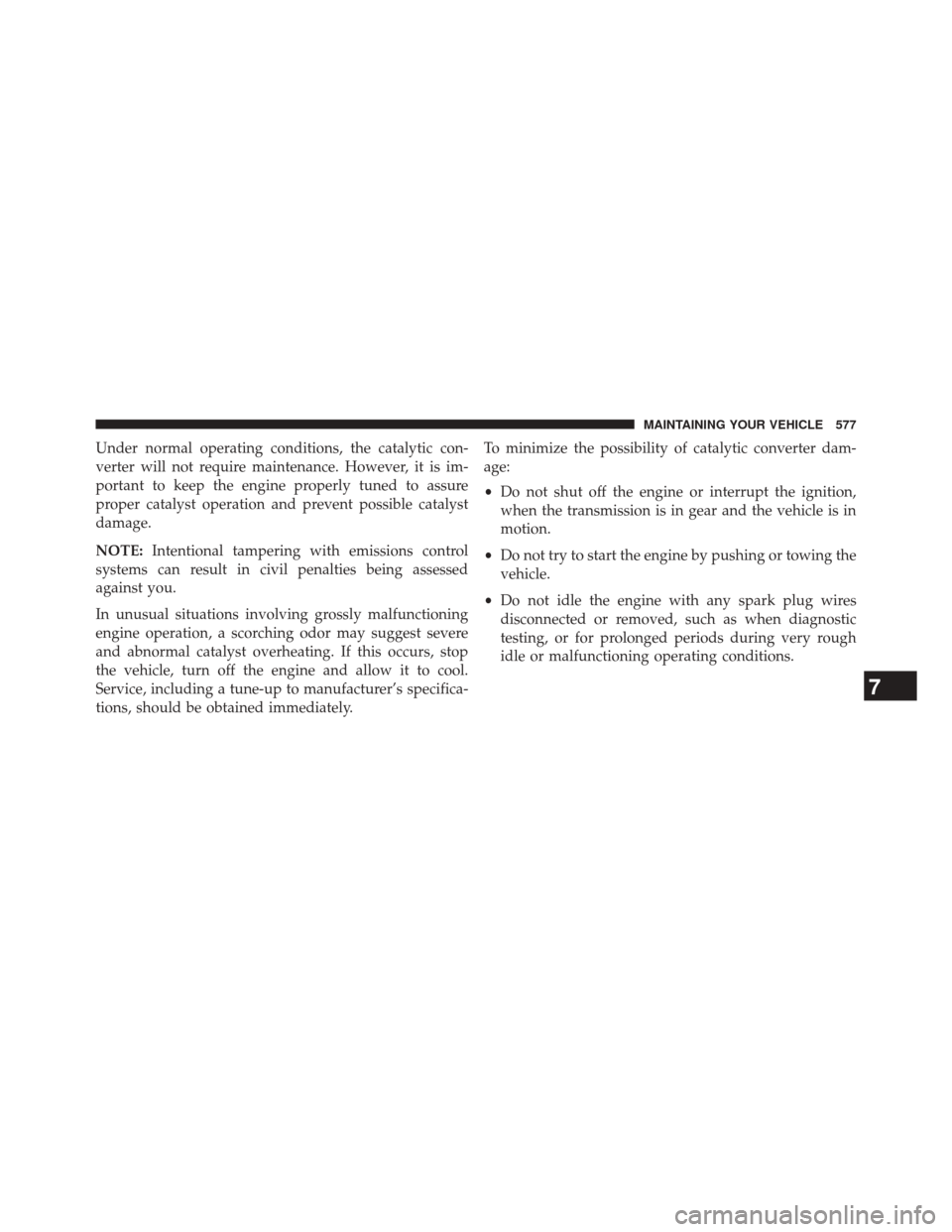
Under normal operating conditions, the catalytic con-
verter will not require maintenance. However, it is im-
portant to keep the engine properly tuned to assure
proper catalyst operation and prevent possible catalyst
damage.
NOTE:Intentional tampering with emissions control
systems can result in civil penalties being assessed
against you.
In unusual situations involving grossly malfunctioning
engine operation, a scorching odor may suggest severe
and abnormal catalyst overheating. If this occurs, stop
the vehicle, turn off the engine and allow it to cool.
Service, including a tune-up to manufacturer’s specifica-
tions, should be obtained immediately. To minimize the possibility of catalytic converter dam-
age:
•
Do not shut off the engine or interrupt the ignition,
when the transmission is in gear and the vehicle is in
motion.
• Do not try to start the engine by pushing or towing the
vehicle.
• Do not idle the engine with any spark plug wires
disconnected or removed, such as when diagnostic
testing, or for prolonged periods during very rough
idle or malfunctioning operating conditions.
7
MAINTAINING YOUR VEHICLE 577
Page 583 of 656
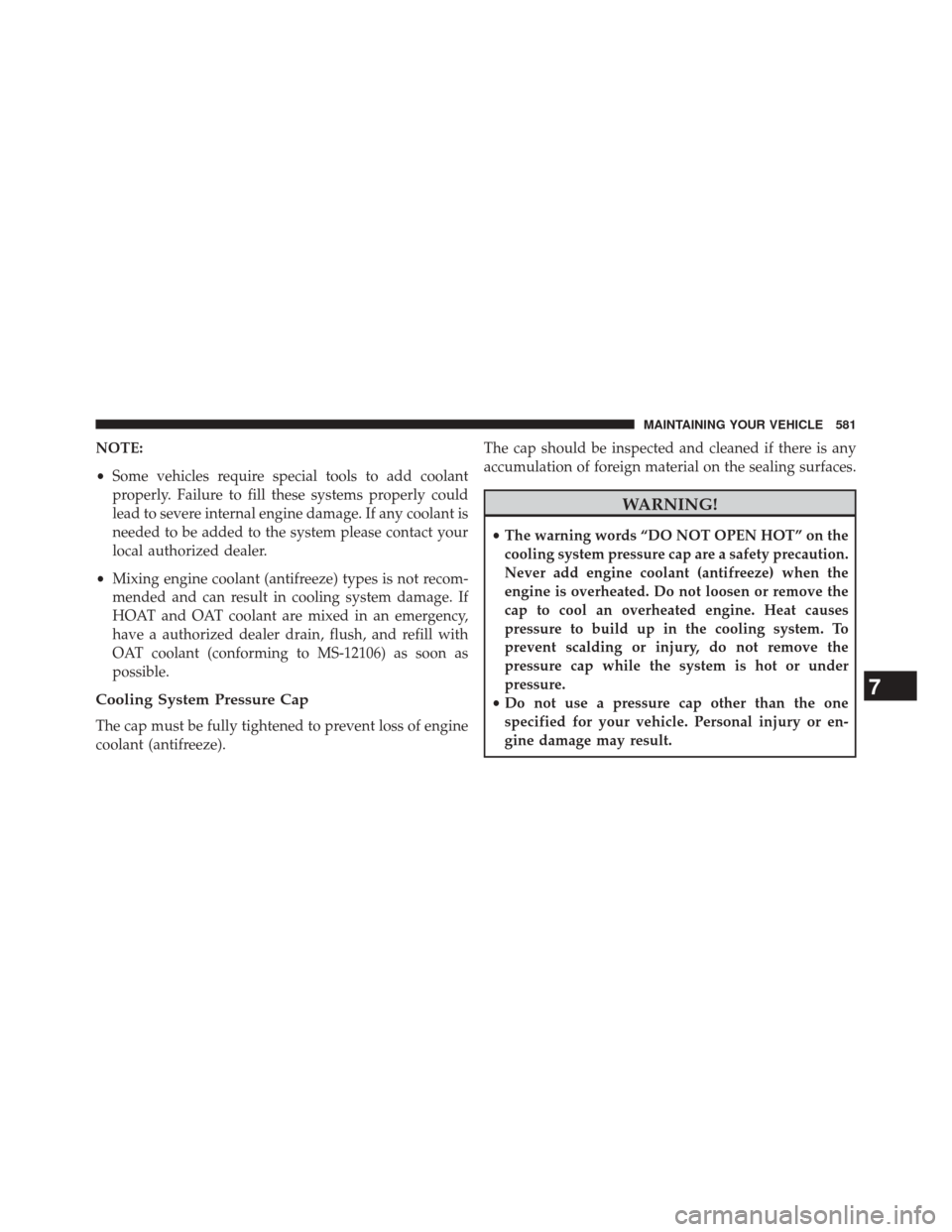
NOTE:
•Some vehicles require special tools to add coolant
properly. Failure to fill these systems properly could
lead to severe internal engine damage. If any coolant is
needed to be added to the system please contact your
local authorized dealer.
• Mixing engine coolant (antifreeze) types is not recom-
mended and can result in cooling system damage. If
HOAT and OAT coolant are mixed in an emergency,
have a authorized dealer drain, flush, and refill with
OAT coolant (conforming to MS-12106) as soon as
possible.
Cooling System Pressure Cap
The cap must be fully tightened to prevent loss of engine
coolant (antifreeze). The cap should be inspected and cleaned if there is any
accumulation of foreign material on the sealing surfaces.
WARNING!
•
The warning words “DO NOT OPEN HOT” on the
cooling system pressure cap are a safety precaution.
Never add engine coolant (antifreeze) when the
engine is overheated. Do not loosen or remove the
cap to cool an overheated engine. Heat causes
pressure to build up in the cooling system. To
prevent scalding or injury, do not remove the
pressure cap while the system is hot or under
pressure.
• Do not use a pressure cap other than the one
specified for your vehicle. Personal injury or en-
gine damage may result.
7
MAINTAINING YOUR VEHICLE 581
Page 639 of 656
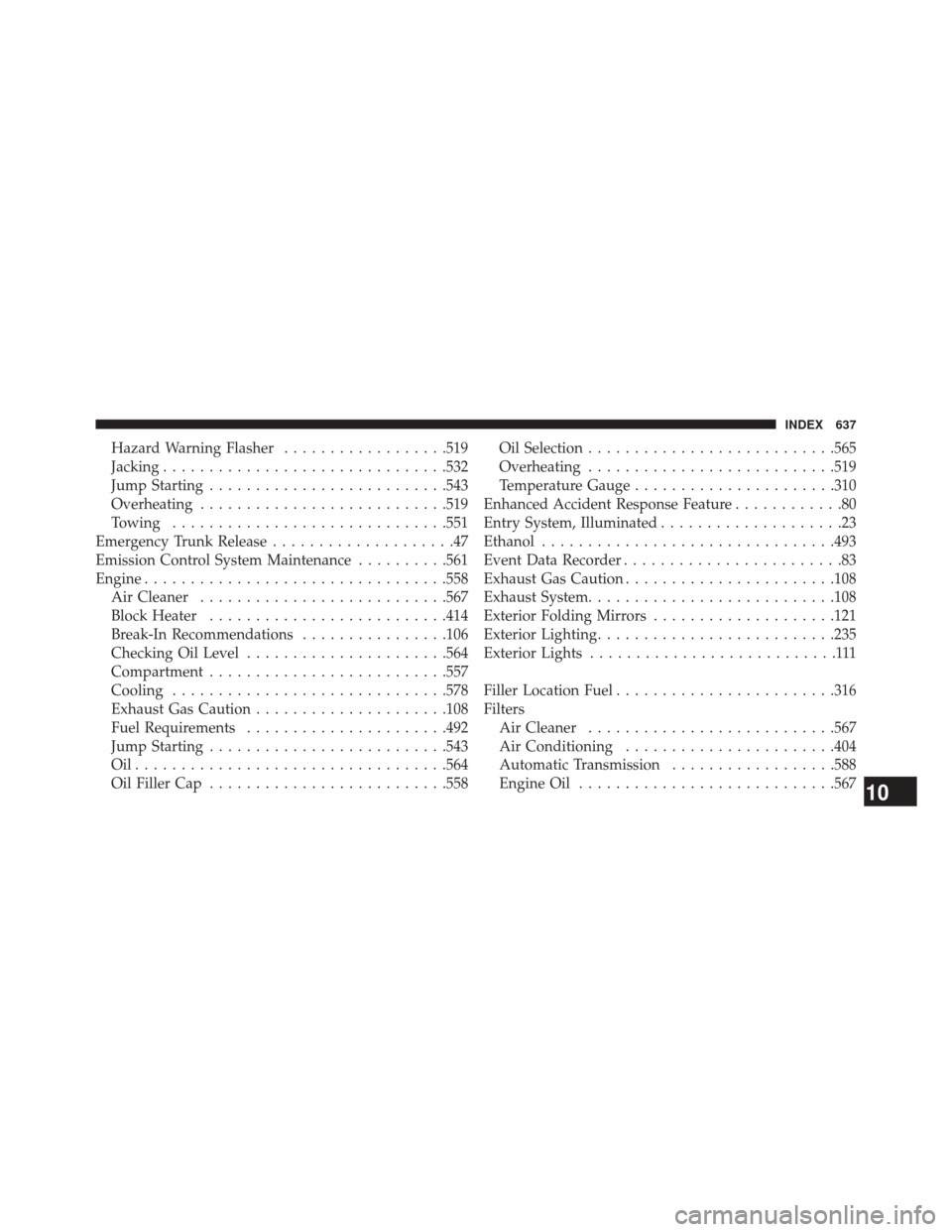
Hazard Warning Flasher..................519
Jacking ...............................532
Jump Starting ..........................543
Overheating .......................... .519
Towing ............................. .551
Emergency Trunk Release ....................47
Emission Control System Maintenance ..........561
Engine .................................558
Air Cleaner .......................... .567
Block Heater ..........................414
Break-In Recommendations ................106
Checking Oil Level ..................... .564
Compartment ..........................557
Cooling ............................. .578
Exhaust Gas Caution .....................108
Fuel Requirements ..................... .492
Jump Starting ..........................543
Oil..................................564
Oil Filler Cap ..........................558 Oil Selection
.......................... .565
Overheating .......................... .519
Temperature Gauge ..................... .310
Enhanced Accident Response Feature ............80
Entry System, Illuminated ....................23
Ethanol ............................... .493
Event Data Recorder ........................83
Exhaust Gas Caution .......................108
Exhaust System .......................... .108
Exterior Folding Mirrors ....................121
Exterior Lighting ..........................235
Exterior Lights ...........................111
Filler Location Fuel ........................316
Filters Air Cleaner .......................... .567
Air Conditioning .......................404
Automatic Transmission ..................588
Engine Oil ............................567
10
INDEX 637
Page 646 of 656
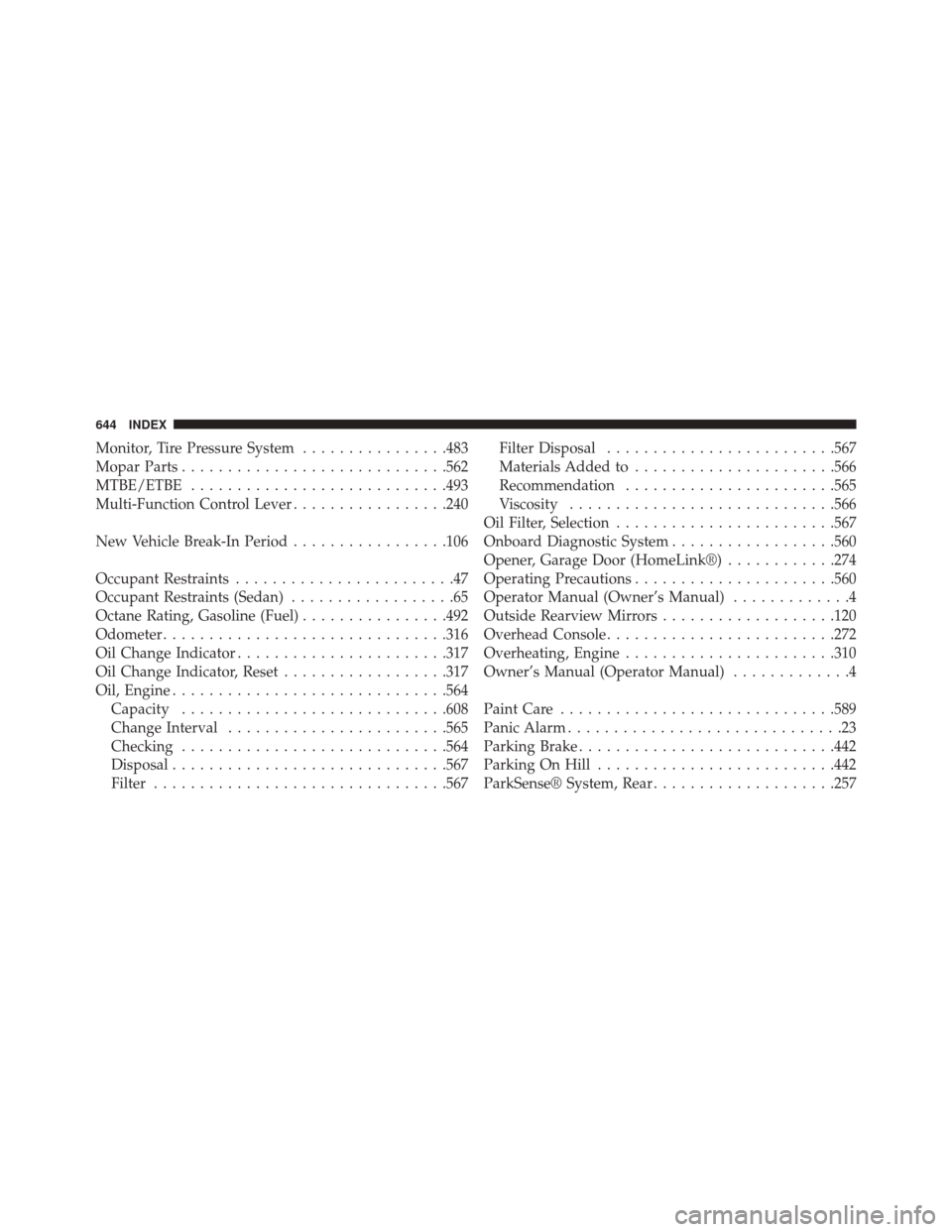
Monitor, Tire Pressure System................483
Mopar Parts ............................ .562
MTBE/ETBE ............................493
Multi-Function Control Lever .................240
New Vehicle Break-In Period .................106
Occupant Restraints ........................47
Occupant Restraints (Sedan) ..................65
Octane Rating, Gasoline (Fuel) ................492
Odometer ...............................316
Oil Change Indicator .......................317
Oil Change Indicator, Reset ..................317
Oil, Engine ............................. .564
Capacity ............................ .608
Change Interval ........................565
Checking ............................ .564
Disposal ............................. .567
Filter ............................... .567Filter Disposal
........................ .567
Materials Added to ..................... .566
Recommendation .......................565
Viscosity ............................ .566
Oil Filter, Selection ........................567
Onboard Diagnostic System ..................560
Opener, Garage Door (HomeLink®) ............274
Operating Precautions ..................... .560
Operator Manual (Owner’s Manual) .............4
Outside Rearview Mirrors ...................120
Overhead Console ........................ .272
Overheating, Engine .......................310
Owner’s Manual (Operator Manual) .............4
Paint Care ............................. .589
Panic Alarm ..............................23
Parking Brake ............................442
Parking On Hill ..........................442
ParkSense® System, Rear ....................257
644 INDEX